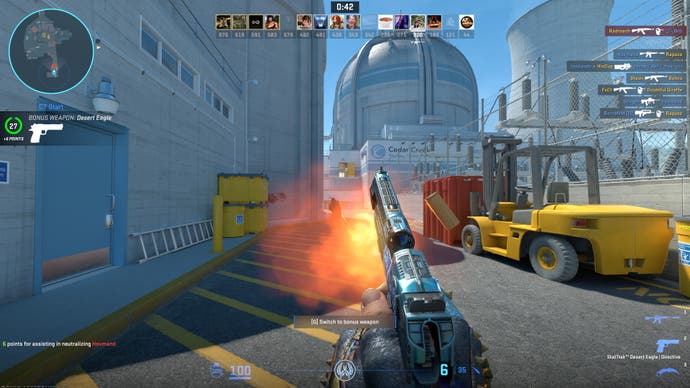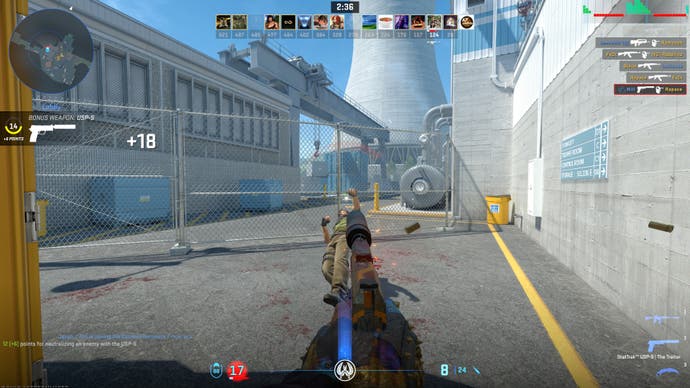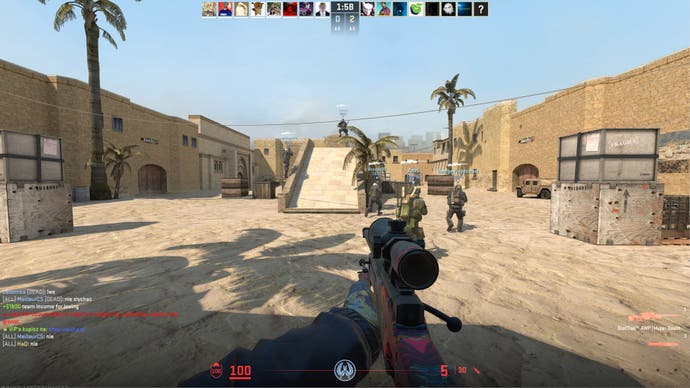Counter-Strike 2 is Counter-Strike. The formula hasn’t really changed since the 1999 original – terrorists and counter-terrorists sparring to eliminate the other side or plant/defuse a bomb at one of two designated locations – but Valve’s 2023 release runs better on modern hardware than 2012’s Global Offensive and offers sparingly more gameplay possibilities too. Fundamentally though, the core combination of tactical, round-based 5v5 competition and satisfyingly difficult shooting mechanics remain as enrapturing and enraging as ever.
Competitive play is at the heart of the game, even more so than in CS:GO, with the Premier ranked mode taking centre stage. Here, solo and grouped players are placed into teams of five, go through a map veto process to select the stage and starting sides, then compete in a best-of-24-rounds match with their individual ELO rating on the line. These matches are a good deal shorter than CS:GO’s best-of-30 contests, increasing the importance of the first rounds on each side and making it a little harder to stage a late comeback.
On the plus side, one-sided stomps are mercifully shortened, while still allowing for overtime in close matches and the exquisite economic interplay that differentiates the game from other shooters. Do you spend all of your hard-earned cash to try and steal a round against better-equipped opponents now, or save your money and accept you’ll lose the next round in order to be on even footing in the round after that?


While competitive matches were also key to predecessor Global Offensive’s appeal – alongside its lucrative market of weapon skins – it also delivered a huge variety of alternative game modes made by enterprising modders, each with their own maps, objectives and flavours. Load up the server browser and download a few extra files when joining, and you could experience all sorts of weird and wonderful mutations that transformed the game well beyond its original design parameters: chill surf servers that challenged you to slip and slide from surface to surface, accelerating you to sufficient speeds to clear huge chasms; giggly-scary cooperative zombie survival matches; outlandishly hard movement skill challenges; useful retake simulations and aim training stages; simple yet iconic deathmatches set amongst ice walls that stick in the memory.
Counter-Strike 2 still has a bit of that retro PC spirit – you can still experiment with powerful console commands, there are still tools to create new maps and assets, the game still runs on an offshoot of ’98 GoldSrc engine – but many of these extra game modes are gone, and the server browser button now pops you out of the game to reveal a vanishly small selection of custom maps and modes.
More may be remade as more tools become available for the new game, but at launch Counter-Strike 2 felt like a much more sterile experience with only competitive, casual, wingman and deathmatch modes built-in. A February ’24 patch did at least add back the “gun game” mode of Arms Race, but the battle royale Danger Zone mode that Valve seemingly poured a tonne of time and energy into remains AWOL. It’s a remodel that may have increased the property’s market value and its appeal to new buyers, but perhaps worn away some of its warmth and personality in the process.

Playing the game solo remains a highly variable experience too. Occasionally you’ll be placed with a friendly team that communicates well and encourages camaraderie – even a simple ‘nt’ in chat after a failed clutch attempt goes a long way – but equally often you’ll get one or more of Counter-Strike’s archetypal bad teammates: quits-at-0:2 guy, mic-eating-violently-racist guy, buying-Deagle-and-dying-in-mid-every-round guy. People are even using the new-found ability to freely place stickers on their weapons to spell out racial epithets. You can quieten, mute or report hostile players, whether they’re on your team or otherwise, but Counter-Strike’s reputation for toxicity remains unfortunately intact in CS2 – you’re never guaranteed a satisfying 45 minutes of action.
When circumstances do align though, the moment-to-moment gunplay and strategic decision-making remain as good as CS:GO or even better. Having fair but fundamentally difficult shooting remains a masterstroke that only Valorant has really copied, with individual skill making the difference between completely whiffed shots and masterful multi-frag spray-downs. Add on similar complexities for other gameplay elements like movement, grenades and economics, and you have a game with a towering skill ceiling, a game where you can always see the results of practice and improvement. Counter-Strike really is what you make of it – a way to blow off steam after work, a skill that you hone over time, a community of passionate players creating content and pushing each other forward, a global esport that fills stadiums and hearts.
While Valve’s previews emphasised the extra tactical possibilities of the new, more realistic smoke grenades, the effect on the game hasn’t been transformative – at least in lower-level matches. It’s now riskier to treat smokes as brick walls, as a well-placed frag grenade could clear the air momentarily to let your opponent get the drop on you, but these sorts of interactions remain rare. Given how well-polished and well-balanced Counter-Strike already was though, clearly a more dramatic shake-up wasn’t needed.


CS2’s maps have also been overhauled, with some levels receiving just the new lighting model and others being remade more completely with new assets and materials. It’s clear that competitive play remains the focus here, with less clutter than other shooters and carefully chosen colours to ensure player models stand out from their environments, but the changes plus VFX and UI tweaks result in a game that feels fresher, brighter and up to modern FPS standards. Flicking onto a target with a sniper rifle or hitting a crisp headshot with a Desert Eagle always felt great in Counter-Strike, but now it looks phenomenal as well.
While Counter-Strike 2’s visuals are much improved compared to its 2012-era predecessor, it still runs extremely well – frame-rates in the hundreds are commonplace even on mid-range hardware, while long-time Counter-Strike video maker 3kliksphilip has shown the game running well on genuinely ancient hardware.
Turning up the fidelity settings to maximum does shift the bottleneck onto the graphics card, requiring a high-end option to sustain play at 4K, but the game’s hardware requirements remain low compared to modern AAA competitors like Call of Duty: Modern Warfare 3 (2023). Input latency is superbly low too, with support for Nvidia’s Reflex tech.

While the game is in a strong state technically, I’d still like to see the addition of temporal upscalers (DLSS 2, FSR 2, XeSS), which would boost performance without the hit to visual quality that the currently-included FSR 1 intrinsically demands. Even frame generation (DLSS 3, FSR 3) technologies could be interesting to play around with, given that 480Hz monitors are on the way and 1000Hz monitors are likely to be available before we see a Counter-Strike 3. The move to Source 2 should allow this kind of tech to be added more easily, so why not experiment?
Perhaps more critically, I’d also like the game’s stability to improve. I don’t remember ever seeing so many random errors and disconnections – of myself, teammates and enemies alike – in CS:GO, but they’re nearly a guarantee over the course of a 45-minute competitive match. It’s intensely frustrating to have a teammate drop out, seemingly losing you a nearly-won game, and of course it doesn’t feel good to win only because you had a numeric advantage either.
With a long enough view though, fractious teammates and random disconnects fall away and Counter-Strike approaches something more akin to a hobby or a sport; it’s something you practice, where you are the only common factor from match to match and the progression of your skills is the real currency of the game, not weapon skins or battle pass level-ups. Climbing that ladder has been one of the most gratifying experiences I’ve ever had in gaming.
All of this makes giving a score to Counter-Strike 2 for the purposes of this review a real challenge – it’s like scoring the game of tennis, or playing the tuba. Counter-Strike as a whole is a stone cold classic game – clearly, the formula works and CS2 is the best implementation of that idea we’ve ever had. But if we’re judging Counter-Strike 2 on its own merits, I don’t think you can make the same argument.
Along with the gameplay innovations and technical improvements, you can point to more controversial changes, like the nebulous subtick networking model, the removal of less-played modes like Demolition and Danger Zone, the flattening of the custom server scene, the connectivity issues, the often hostile playerbase and inscrutable mechanics that greet newcomers. These aren’t the hallmarks of an top-tier evolution, and there’s clearly some way to go before CS2 reaches the same legendary status of its predecessor.
For all its foibles though, I have confidence that Valve is at least pushing the game in the right direction. After all, both CS: Source and CS:GO evolved considerably after their initial launch and became classics in their own right, and all the building blocks are here for Counter-Strike 2 to follow the same trajectory – and from a much better starting position. The bottom line? This is already an incredible game that’s well worth playing – after all, it is Counter-Strike, too.
